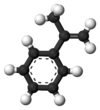''alpha''-Methylstyrene
| |||
| Names | |||
|---|---|---|---|
| IUPAC name
Isopropenylbenzene | |||
| Other names
α-Methylstyrene; 2-Phenyl-1-propene; 1-Methyl-1-phenylethylene; 2-Phenylpropene; (1-Methylethenyl)benzene; beta-Phenylpropene; 2-Phenylpropylene; beta-Phenylpropylene; alpha-Methylstyrol; 1-Phenyl-1-methylethylene; 2-Phenyl-2-propene | |||
| Identifiers | |||
| 3D model (JSmol) |
|||
| Abbreviations | AMS | ||
| ChemSpider | |||
| ECHA InfoCard | 100.002.459 | ||
| KEGG | |||
| PubChem CID |
|||
| |||
| |||
| Properties | |||
| C9H10 | |||
| Molar mass | 118.18 g·mol−1 | ||
| Appearance | Colorless liquid | ||
| Density | 0.91 g/cm3 | ||
| Melting point | −24 °C (−11 °F; 249 K) | ||
| Boiling point | 165 to 169 °C (329 to 336 °F; 438 to 442 K) | ||
| Insoluble | |||
| Vapor pressure | 2 mmHg (20 °C)[1] | ||
| -80.1·10−6 cm3/mol | |||
| Hazards | |||
| NFPA 704 | |||
| Flash point | 45 °C (113 °F; 318 K) | ||
| Explosive limits | 1.9%-6.1%[1] | ||
| Lethal dose or concentration (LD, LC): | |||
| LD50 (median dose) |
4900 mg/kg (oral, rat)[2] | ||
| US health exposure limits (NIOSH): | |||
| PEL (Permissible) |
C 100 ppm (480 mg/m3)[1] | ||
| REL (Recommended) |
TWA 50 ppm (240 mg/m3) ST 100 ppm (485 mg/m3)[1] | ||
| IDLH (Immediate danger) |
700 ppm[1] | ||
| Except where otherwise noted, data are given for materials in their standard state (at 25 °C [77 °F], 100 kPa). | |||
| | |||
| Infobox references | |||
α-Methylstyrene (AMS) is a chemical intermediate used in the manufacture of plasticizers, resins and polymers.[3] It is a co-product formed in a variation of the cumene process. The homopolymer obtained from this monomer, poly(α-methylstyrene), is unstable, being characterized by a low ceiling temperature.
References
- 1 2 3 4 5 "NIOSH Pocket Guide to Chemical Hazards #0429". National Institute for Occupational Safety and Health (NIOSH).
- ↑ "alpha-Methyl styrene". Immediately Dangerous to Life and Health. National Institute for Occupational Safety and Health (NIOSH).
- ↑ What is alpha-methylstyrene (AMS)?
This article is issued from
Wikipedia.
The text is licensed under Creative Commons - Attribution - Sharealike.
Additional terms may apply for the media files.


